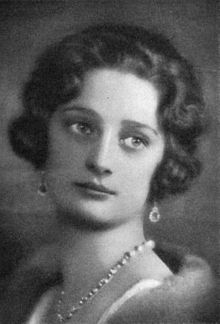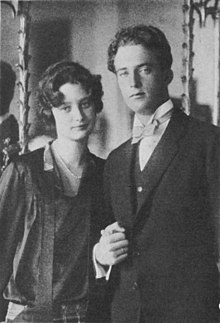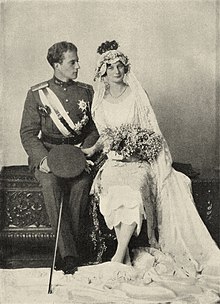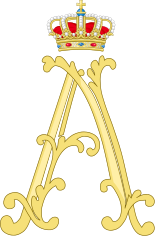Astrid of Sweden
This article includes a list of references, but its sources remain unclear because it has insufficient inline citations. (May 2011) (Learn how and when to remove this template message) |
| Astrid of Sweden | |||||
|---|---|---|---|---|---|
 Astrid as Duchess of Brabant in 1926 | |||||
| Queen consort of the Belgians | |||||
| Tenure | 17 February 1934 – 29 August 1935 | ||||
| Born | (1905-11-17)17 November 1905 Arvfurstens palats, Stockholm, Sweden | ||||
| Died | 29 August 1935(1935-08-29) (aged 29) Küssnacht am Rigi, Schwyz, Switzerland | ||||
| Burial | 3 September 1935 Church of Our Lady of Laeken | ||||
| Spouse | Leopold III, King of the Belgians (m. 1926) | ||||
| Issue |
| ||||
| |||||
| House | Bernadotte | ||||
| Father | Prince Carl, Duke of Västergötland | ||||
| Mother | Princess Ingeborg of Denmark | ||||
Astrid of Sweden (17 November 1905 – 29 August 1935) was Queen of the Belgians as the first wife of King Leopold III. By birth she was a princess of Sweden's royal House of Bernadotte. She was queen for less than two years, dying in a car accident at age 29. Her only daughter, Joséphine-Charlotte later became Grand Duchess of Luxembourg while both of her sons, reigned as King of the Belgians. Her grandsons include King Philippe of Belgium and Henri, Grand Duke of Luxembourg. Astrid was also a maternal aunt of King Harald V of Norway.
Contents
1 Early life
2 Engagement and wedding
3 Married life
4 Conversion to Catholicism
5 Queen
6 Death
7 Legacy
8 Titles, styles, honours and arms
8.1 Titles and styles
8.2 Honours
8.3 Arms
9 Ancestry
10 References
11 External links
Early life

Astrid with her mother and sisters
Princess Astrid was born on 17 November 1905, at the Arvfurstens Palats in Stockholm as the third child and youngest daughter of Prince Carl, Duke of Västergötland, and his wife, Princess Ingeborg of Denmark. Her father was the third son of Oscar II, King of Sweden and Norway, by his wife, Sophia of Nassau. Her mother was a daughter of King Frederick VIII of Denmark by his wife, Louise of Sweden. Astrid's father was a younger brother of King Gustav V of Sweden, and her mother was the younger sister of kings Christian X of Denmark and Haakon VII of Norway.
Astrid had two elder sisters Margaretha, Princess Axel of Denmark, and Märtha, Crown Princess of Norway, and a younger brother Prince Carl Bernadotte (prev. Prince Carl of Sweden, Duke of Östergötland).
Astrid spent most of her childhood at Arvfurstens Palace in central Stockholm and at the family's summer residence in Fridhem. Astrid was raised in the strict education and without much luxury. Astrid attended the Sint Botvid boarding school, where lessons were taught in French. She then went to Akerstrom-Soderstrom finishing school.[2] She studied sewing, piano, ballet and childcare.
As did many princesses of the time, Astrid was encouraged to undertake works of public service in preparation for a life devoted to charitable causes. She worked for a time at a Stockholm orphanage, caring for infants.[3]
Astrid enjoyed the outdoors and sports such swimming, skiing, climbing, horseback riding, and golf.[4] She and her sisters were occasionally seen shopping unaccompanied on the streets of Stockholm.[5]
Engagement and wedding

Engagement of Princess Astrid and Prince Leopold on 21 September 1926
As an eligible princess, Astrid was mentioned as a potential bride for a number of princes including the future Edward VIII of the United Kingdom and the future Olav V of Norway. Astrid's successful suitor was Prince Leopold of Belgium, Duke of Brabant.
In September 1926, their engagement was announced. King Albert I and Queen Elisabeth of Belgium invited the press to the royal palace in Brussels. "The Queen and I," declared Albert, "would like to announce to you the impending marriage between Prince Leopold, Duke of Brabant and the Princess Astrid of Sweden. We are convinced that the princess will bring joy and happiness to our son. Leopold and Astrid have decided to join their lives without any pressures or reasons of state. Theirs is a true union among people with the same inclinations." Queen Elisabeth, incorrigible romantic that she was, insisted in saying "It is a marriage of love... tell it to our people. Nothing was arranged. Not a single political consideration prevailed in our son's decision."

Astrid of Sweden and Leopold of Belgium on their wedding day.
In Stockholm on 4 November 1926 civilly and in Cathedral of St. Michael and St. Gudula, Brussels on 10 November religiously, Princess Astrid married Prince Leopold. The couple travelled separately to Antwerp after their civil marriage, to be reunited in Belgium.
For the religious marriage, the couple were attended by a large wedding party of young friends and relatives: Princess Feodora of Denmark, Princess Marie-José of Belgium, Princess Märtha of Sweden, Princess Ingrid of Sweden, Alfhild Ekelund, Prince Carl of Sweden, Prince Gustav Adolf of Sweden, Crown Prince Olav of Norway, Margareta Stähl, Count Claes Sparre, Anna Adelswärd, Prince Charles of Belgium, Count Folke Bernadotte, Baron Sigvard Beck-Friis, Anne Marie von Essen, and Baron Carl Strömfelt.[6]
Princess Astrid was given a tiara as a wedding gift from the Belgian government, created by Belgian jeweler Van Bever, the original version of the diadem is a flexible diamond bandeau in a stylized Greek key motif topped with 11 large diamonds on spikes. These large stones, totaling around 100 carats on their own, symbolize the nine provinces of Belgium and the (now former) Belgian colony of the Congo. She later added a set of diamond arches to enclose each of the 11 independent stones. After Astrid's death the tiara was in the possession of King Leopold, and his second wife Lilian, Princess of Réthy wore parts of the tiara but not the full gem (Lilian never held the title of Queen). Leopold abdicated the throne in favor of his son Baudouin; when Baudouin married, Leopold gave the tiara to the new queen. Fabiola, Belgium's first queen since Astrid, wore it on her wedding day. She handed the jewel over after Baudouin's death to be worn by Queen Paola who, after the abdication of her husband Albert, gave it to Mathilde new Queen of the Belgians.
Married life

Astrid of Sweden.
Astrid and her husband spent their honeymoon in south of France before moving into a wing of the Royal Palace in Brussels. After the honeymoon period, Astrid began studying French and Dutch.[7]
Astrid was enthusiastically adopted by the Belgians. She was widely loved for her beauty, charm and simplicity. Her public and official engagements radiated enthusiasm. As Duchess of Brabant, she worked tirelessly to alleviate various forms of adversity.[8] Leopold was her most fervent admirer. The love shared by the young couple was evident to all. On more than one occasion people could see them holding hands, even during official engagements.
In October 1927, Leopold and Astrid had a daughter, Princess Joséphine-Charlotte, who later married Jean of Luxembourg in April 1953 and became Grand Duchess consort of Luxembourg in November 1964. One year later, she and her husband visit Dutch East Indies (now Indonesia).[9]
In 1930, the Belgian press gave extensive coverage to the birth of the long-awaited royal heir. Leopold was on his way to visit some areas away from Brussels when the Duchess of Brabant went into labor. The royal palace immediately sent him a telegram that reached Leopold at a stop during his journey. The royal palace's message announced the impending birth of the couple's second child. Without thinking twice about the day's engagements, Leopold returned to Brussels immediately. Prince Leopold and King Albert I walked anxiously in the garden at Stuyvenberg Castle while the Duchess of Brabant began her labor. Next to Astrid were her mother, the Duchess of Västergötland, and her mother-in-law, the Queen. At 4:15 pm the royal physicians proudly announced the healthy birth of a little prince. The sound of a cannon silenced the general happiness expressed by the people of Brussels. Their first son, Baudouin eventually succeeded his father as King of the Belgians. He was given the name of Baudouin in memory of his deceased granduncle who was supposed to have become king.
At Stuyvenberg, not far away from the Royal Castle of Laeken, the young Duchess of Brabant, raised in the simplicity of the Scandinavian courts, joyfully raised her growing family. At a small villa in the palace grounds, Astrid cooked for her family. And every time she could, Astrid would stroll along the Avenue Louise with her children. The Court Marshall vehemently protested against these promenades. "They break protocol," he would say. Yet in her simplicity, Astrid would retort by saying "But I'm just another mother, am I not?" She even went as far as joining the crowds during a military revenue in an effort to see her promenading husband at the head of his regiment.
Conversion to Catholicism
Raised as a Lutheran, Astrid converted to Catholicism after marrying Leopold. She had initially considered converting to Catholicism, simply because it was the religion of Belgium, but the priest she consulted, Father William Hemmick, told her not to do so until she genuinely believed it was the true religion.[10]
Astrid learned more about Catholicism and, several years later, in 1930, converted from genuine conviction. Her decision made her happy, and she confided to a close childhood friend: "My soul has found peace."[11] Her father-in-law, King Albert I, who was very devout himself, repeated, on the day of Astrid's conversion: "I am glad, very glad. Now all the family is united in the same religion."[12]
Queen

Queen Astrid of Belgium in 1935.
On 17 February 1934, King Albert I died in a mountain-climbing accident in Marche-les-Dames, Belgium. Leopold and Astrid became the new King and Queen of the Belgians with the style of Majesty. Later that year, the third child of Leopold and Astrid was born. He was named Albert after his grandfather, and would eventually succeed his brother Baudouin as King of the Belgians.
As queen, Astrid dedicated her time to raising her family and promoting social causes which brought her into contact with the Belgians.[13] She was very concerned with the situation of women, children, and disadvantaged people. During an economic crisis in Belgium in 1935, she organized a collection of clothing, money and food for the poor. She did this through an open letter, which was published as the "Queen’s Appeal". Queen Astrid also visited many poor settlement in Belgium.
Death

Funeral of Astrid

Astrid chapel in Küssnacht am Rigi
In August 1935, the King and Queen went incognito to Switzerland on holiday. Prince Albert remained in Brussels. Only one year old, he was considered too young for the journey. Joséphine-Charlotte and Baudouin had travelled with their parents to their holiday home, Villa Haslihorn in Horw, Switzerland. The children were sent back to Belgium with their nannies on 28 August.
On 29 August 1935, the King and Queen decided to go for a last hike in the mountains before returning home. Their chauffeur was sitting in the back of the Packard One-Twenty convertible, the King was driving and the Queen looking at a map. As the Queen pointed out something to her husband the car went off the road, down a steep slope, and slammed into a pear tree. Queen Astrid had opened her door to try to get out, but she was thrown out upon impact. Her body collided with the trunk of the tree, while the car slammed into a second tree. King Leopold was thrown out of the car as well, but he was only lightly injured. The car went on, only to stop in a lake. It was 9:30 am on 29 August 1935. The Queen died from her injuries at the scene of the accident at Küssnacht am Rigi, near Lake Lucerne, Schwyz, Switzerland.
Queen Astrid is interred in the royal vault at the Church of Our Lady of Laeken, Brussels, beside her husband, King Leopold III of the Belgians, and his second wife, Lilian, Princess of Réthy.
Legacy

Statue of Astrid in a park at Kortrijk named for her
The queen was deeply mourned by her husband, King Leopold, by the Belgians, and by the Swedes. In 1935, the Belgian postal authorities issued a postage stamp showing her portrait outlined in black, known as the Astrid Mourning issue. Later that same year, it released a series of anti-tuberculosis fund stamps with the same design.[14]
A commemorative chapel was built in Switzerland at the site of the crash. The chapel has become a destination for Swedish and Belgian tourists. A museum nearby holds images and memorabilia of the event, including a shard from the windscreen and the log of the pear tree. The tree itself was felled by a storm in 1992. The car was sunk at a deep part of the Vierwaldstättersee at the request of the king.[15]
As of May 2018[update], two of her grandchildren are reigning monarchs; King Philippe of Belgium and Henri, Grand Duke of Luxembourg. She was also a maternal aunt of King Harald V of Norway. Four of her female descendants have been named Astrid to honour her, her granddaughters Archduchess Marie Astrid of Austria, Princess Astrid of Belgium, her great-granddaughter Princess Marie-Astrid of Liechtenstein, and her great-great-granddaughter Archduchess Anna Astrid of Austria-Este. Her niece Princess Astrid of Norway (later Mrs. Ferner) was named to honour her.
Astrid Avenue in Bogor Botanical Garden in Indonesia (formerly Dutch East Indies) was named after her when she was honeymoon with her spouse in 1928, the avenue is decorated with spectacular display of canna lilies of various colors.[16][17]
The popular Swedish layer cake Princess cake was named after Astrid and her two sisters when they were children.
Titles, styles, honours and arms
Titles and styles
- 17 November 1905 – 4 November 1926: Her Royal Highness Princess Astrid of Sweden
- 4 November 1926 – 17 February 1934: Her Royal Highness The Duchess of Brabant
- 17 February 1934 – 29 August 1935: Her Majesty The Queen of the Belgians
Honours
 Sovereign Military Order of Malta: Bailiff Dame Grand Cross of Obedience of the Sovereign Military Order of Malta[18]
Sovereign Military Order of Malta: Bailiff Dame Grand Cross of Obedience of the Sovereign Military Order of Malta[18]
Arms
 Alliance Coat of Arms of King Leopold III and Queen Astrid of Belgium Alliance Coat of Arms of King Leopold III and Queen Astrid of Belgium |  Royal Monogram of Queen Astrid of Belgium Royal Monogram of Queen Astrid of Belgium |
Ancestry
.mw-parser-output table.ahnentafelborder-collapse:separate;border-spacing:0;line-height:130%.mw-parser-output .ahnentafel trtext-align:center.mw-parser-output .ahnentafel-tborder-top:#000 solid 1px;border-left:#000 solid 1px.mw-parser-output .ahnentafel-bborder-bottom:#000 solid 1px;border-left:#000 solid 1px
| Ancestors of Astrid of Sweden | ||||||||||||||||||||||||||||||||||||||||||||||||||||||||||||||||||||||||||||||||||||||||||||||||||||||||||||||||||||||||||||||||||||||||||||||||||||||||||||||||||||||||||||||||||||||||||||||||||||||||||||||||||||||||||||||||||||||||||||||||||||||||||||||||||||||||||||||||||||||||||||||||||||||||||||||||||||||||||||||||||||||||||||||||||||||||||||||||||||||||||||||||||||||||||||||||||||||||||||||||||||||||||||||||||||||||||||||||||||||||||||||||||||||||||||||||||||||||||||||||||||||||||||||||||||||||||||||||||||||||||||||||||||||||||||||||||||||||||||||||||||||||||||||||||||||||||||||||
|---|---|---|---|---|---|---|---|---|---|---|---|---|---|---|---|---|---|---|---|---|---|---|---|---|---|---|---|---|---|---|---|---|---|---|---|---|---|---|---|---|---|---|---|---|---|---|---|---|---|---|---|---|---|---|---|---|---|---|---|---|---|---|---|---|---|---|---|---|---|---|---|---|---|---|---|---|---|---|---|---|---|---|---|---|---|---|---|---|---|---|---|---|---|---|---|---|---|---|---|---|---|---|---|---|---|---|---|---|---|---|---|---|---|---|---|---|---|---|---|---|---|---|---|---|---|---|---|---|---|---|---|---|---|---|---|---|---|---|---|---|---|---|---|---|---|---|---|---|---|---|---|---|---|---|---|---|---|---|---|---|---|---|---|---|---|---|---|---|---|---|---|---|---|---|---|---|---|---|---|---|---|---|---|---|---|---|---|---|---|---|---|---|---|---|---|---|---|---|---|---|---|---|---|---|---|---|---|---|---|---|---|---|---|---|---|---|---|---|---|---|---|---|---|---|---|---|---|---|---|---|---|---|---|---|---|---|---|---|---|---|---|---|---|---|---|---|---|---|---|---|---|---|---|---|---|---|---|---|---|---|---|---|---|---|---|---|---|---|---|---|---|---|---|---|---|---|---|---|---|---|---|---|---|---|---|---|---|---|---|---|---|---|---|---|---|---|---|---|---|---|---|---|---|---|---|---|---|---|---|---|---|---|---|---|---|---|---|---|---|---|---|---|---|---|---|---|---|---|---|---|---|---|---|---|---|---|---|---|---|---|---|---|---|---|---|---|---|---|---|---|---|---|---|---|---|---|---|---|---|---|---|---|---|---|---|---|---|---|---|---|---|---|---|---|---|---|---|---|---|---|---|---|---|---|---|---|---|---|---|---|---|---|---|---|---|---|---|---|---|---|---|---|---|---|---|---|---|---|---|---|---|---|---|---|---|---|---|---|---|---|---|---|---|---|---|---|---|---|---|---|---|---|---|---|---|---|---|---|---|---|---|---|---|---|---|---|---|---|---|---|---|---|---|---|---|---|---|---|---|---|---|---|---|---|---|---|---|---|---|---|---|---|---|---|---|---|---|---|---|---|---|---|---|---|---|---|---|---|---|---|---|---|---|---|---|---|---|---|---|---|---|---|---|---|---|---|---|---|---|---|---|---|---|---|---|---|---|---|---|---|---|---|---|---|---|---|---|---|---|---|---|---|---|---|---|---|---|---|---|---|---|---|---|---|---|---|---|---|---|---|---|---|---|---|---|---|---|---|---|---|---|---|---|---|---|---|---|---|---|---|---|---|---|---|---|---|---|---|---|---|---|---|---|---|---|---|---|---|---|---|---|---|
| ||||||||||||||||||||||||||||||||||||||||||||||||||||||||||||||||||||||||||||||||||||||||||||||||||||||||||||||||||||||||||||||||||||||||||||||||||||||||||||||||||||||||||||||||||||||||||||||||||||||||||||||||||||||||||||||||||||||||||||||||||||||||||||||||||||||||||||||||||||||||||||||||||||||||||||||||||||||||||||||||||||||||||||||||||||||||||||||||||||||||||||||||||||||||||||||||||||||||||||||||||||||||||||||||||||||||||||||||||||||||||||||||||||||||||||||||||||||||||||||||||||||||||||||||||||||||||||||||||||||||||||||||||||||||||||||||||||||||||||||||||||||||||||||||||||||||||||||||
References
- Catherine Barjansky. "Portraits with Backgrounds."
- Art Beeche. "The Snow Princess."
- Robert Capelle. "Dix-huit ans auprès du Roi Léopold."
- Charles d'Ydewalle. "Albert and the Belgians: Portrait of a King."
- Evelyn Graham. "Albert King of the Belgians."
- Luciano Regolo. "La Regina Incompresa."
- Lars Rooth. "More Joy Than Pain."
- Anna Sparre. "Astrid mon amie."
^ Burke's Royal Families of the World .mw-parser-output cite.citationfont-style:inherit.mw-parser-output qquotes:"""""""'""'".mw-parser-output code.cs1-codecolor:inherit;background:inherit;border:inherit;padding:inherit.mw-parser-output .cs1-lock-free abackground:url("//upload.wikimedia.org/wikipedia/commons/thumb/6/65/Lock-green.svg/9px-Lock-green.svg.png")no-repeat;background-position:right .1em center.mw-parser-output .cs1-lock-limited a,.mw-parser-output .cs1-lock-registration abackground:url("//upload.wikimedia.org/wikipedia/commons/thumb/d/d6/Lock-gray-alt-2.svg/9px-Lock-gray-alt-2.svg.png")no-repeat;background-position:right .1em center.mw-parser-output .cs1-lock-subscription abackground:url("//upload.wikimedia.org/wikipedia/commons/thumb/a/aa/Lock-red-alt-2.svg/9px-Lock-red-alt-2.svg.png")no-repeat;background-position:right .1em center.mw-parser-output .cs1-subscription,.mw-parser-output .cs1-registrationcolor:#555.mw-parser-output .cs1-subscription span,.mw-parser-output .cs1-registration spanborder-bottom:1px dotted;cursor:help.mw-parser-output .cs1-hidden-errordisplay:none;font-size:100%.mw-parser-output .cs1-visible-errorfont-size:100%.mw-parser-output .cs1-subscription,.mw-parser-output .cs1-registration,.mw-parser-output .cs1-formatfont-size:95%.mw-parser-output .cs1-kern-left,.mw-parser-output .cs1-kern-wl-leftpadding-left:0.2em.mw-parser-output .cs1-kern-right,.mw-parser-output .cs1-kern-wl-rightpadding-right:0.2em
ISBN 0 85011 023 8 p. 514 (spelling of her full name as baptized)
^ "Astrid of Sweden – Queen of Hearts". History of Royal Women.
^ McMahon, Emily. "Wedding of King Leopold III of the Belgians and Princess Astrid of Sweden". Unofficial Royalty. Retrieved 29 September 2018.
^ McMahon, Emily. "Wedding of King Leopold III of the Belgians and Princess Astrid of Sweden". Unofficial Royalty. Retrieved 29 September 2018.
^ McMahon, Emily. "Wedding of King Leopold III of the Belgians and Princess Astrid of Sweden". Unofficial Royalty. Retrieved 29 September 2018.
^ McMahon, Emily. "Wedding of Leopold III and Astrid of Sweden". Unofficial Royalty.
^ "Astrid of Sweden – Queen of Hearts". History of Royal Women.
^ "Princess Astrid (1905-35)". Swedish Royal Court.
^ Priherdityo, Endro (16 March 2016). "Kisah Cinta Putri Belgia Masih Tersimpan di Kebun Raya Bogor" [The Memory of Belgian Princess's Love Story Is Still Saved in the Bogor Botanical Garden]. CNN Indonesia (in Indonesian). Retrieved 23 October 2018.
^ More Joy Than Pain, 1991, by Lars Rooth pp. 84–85
^ Quoted by Anna Sparre in Astrid mon amie, 2005, p. 128
^ Quoted by Charles d'Ydewalle in Albert and the Belgians: Portrait of a King, 2005, p. 259
^ "Queen Astrid of Belgium". Unofficial Royalty. Retrieved 29 September 2018.
^ Stanley Gibbons Simplified catalogue. Stamps of the World, 1985 Edition
^ Der belgische König kommt nach Küssnacht Neue Zürcher Zeitung
^ "Taman Astrid - Kebun Raya Bogor". Lovely Bogor (in Indonesian).
^ Priherdityo, Endro (16 March 2016). "Kisah Cinta Putri Belgia Masih Tersimpan di Kebun Raya Bogor" [The Memory of Belgian Princess's Love Story Is Still Saved in the Bogor Botanical Garden]. CNN Indonesia (in Indonesian). Retrieved 23 October 2018.
^ https://s-media-cache-ak0.pinimg.com/736x/df/32/21/df322157135717c6c324c204c1264ae8.jpg
External links
| Wikimedia Commons has media related to Astrid of Sweden. |
Royal Love Match (1926), newsreel on the British Pathé YouTube Channel
Tragic Death of the Queen of the Belgians (1935), newsreel on the British Pathé YouTube Channel- Astrid's Conversion to Catholicism
- The Queen's Charity Drive, 1935
- Portraits of the Nation: Postage Stamps and National Identity
The making of a Belgicist reference to Villa Haslihorn
Packard Club images from the Packard car after the accident
BELGIUM: Death of Astrid Time article
Newspaper clippings about Astrid of Sweden in the 20th Century Press Archives of the German National Library of Economics (ZBW)
Astrid of Sweden House of Bernadotte Born: 17 November 1905 Died: 29 August 1935 | ||
Belgian royalty | ||
|---|---|---|
| Preceded by Elisabeth of Bavaria | Queen consort of the Belgians 1934–1935 | Vacant Title next held by Fabiola de Mora y Aragón |
